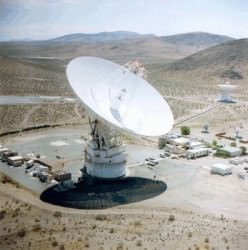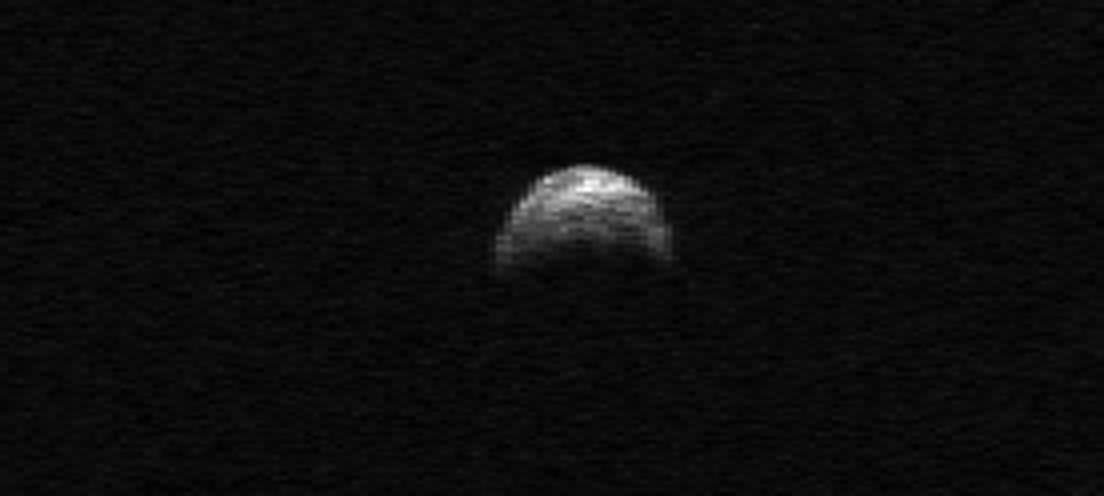[/caption]
On Tuesday, November 8, at 6:28 p.m. EST, an asteroid the size of an aircraft carrier will soar past our planet at a distance closer than the Moon… and NASA scientists will be watching!
2005 YU55, a 400-meter (1,300-foot) -wide C-type asteroid, was discovered in December 2005 by Robert McMillan of the Spacewatch Program at the University of Arizona, Tucson. It’s pretty much spherical in shape and dark – darker than charcoal, in fact! Scientists with NASA’s Near-Earth Objects Observation Program will begin tracking it on November 4 using the 70-meter radar telescope at the Deep Space Network in Goldstone, California , as well as with the Arecibo Planetary Radar Facility in Puerto Rico beginning November 8. They will continue tracking 2005 YU55 through November 10.

YU55’s orbit is well understood by scientists. It has come this way before, and although this is the closest it’s come to Earth in at least two centuries it will still be at least 324,600 kilometers (201,700 miles) away at nearest approach. That’s about 85% of the distance to the Moon.
It will approach from the sunward side, making viewing in visible light difficult until after it’s made its closest pass.
Other than the excitement it will most likely cause amongst radar astronomers, 2005 YU55 will have no physical effect on our planet. (There have been some rumors circulating online about this particular asteroid’s upcoming pass, in regards to earthquakes and tidal fluctuations and atmospheric disturbances and other such nonsense… the bottom line is that, like the ill-fated comet Elenin, 2005 YU55 has never been known to pose any threat to Earth.)
“YU55 poses no threat of an Earth collision over, at the very least, the next 100 years,” said Don Yeomans, manager of NASA’s Near-Earth Object Program Office at JPL. “During its closest approach, its gravitational effect on the Earth will be so miniscule as to be immeasurable. It will not affect the tides or anything else.”

Scientists are very eager though to have a prime opportunity to study this quarter-mile-wide world as it makes its closest pass. The giant telescopes at Goldstone and Arecibo will bounce radar waves off the asteroid, mapping its size and shape, and hopefully obtain some very high-resolution images.
“Using the Goldstone radar operating with the software and hardware upgrades, the resulting images of YU55 could come in with resolution as fine as 4 meters per pixel. We’re talking about getting down to the kind of surface detail you dream of when you have a spacecraft fly by one of these targets.”
– Lance Benner, JPL radio astronomer
Even though YU55 will remain at a safe distance the event is still quite notable. The last time an object this large came so close to Earth was in 1976… and scientists weren’t even aware of it at the time. Luckily we now have programs like the Near-Earth Objects Observations Program – a.k.a. “Spaceguard” – to identify asteroids like this, hopefully in time to know if they could become a danger to our planet in either the near or distant future.
As of now, no large space rock with Earth’s name on it has been positively identified… but that doesn’t mean there’s nothing out there either. We need to keep diligent, keep looking and, above all, keep funding programs like this. If anything, this pass should serve as a reminder – however harmless – that we certainly are not alone in the solar system!
Read more on the NASA/JPL press release here.
UPDATE: NASA will be holding a live Q&A on 2005 YU55 and other near-Earth objects on November 1 at 2:30 p.m. PDT (5:30 p.m. EDT)… watch live here.


strange that nostradarmous predicted that the world would end in 2012 after 3 world leaders had been killed! sadam husein, bin laden, kernal gudaffe all bite the bullit and now this aseroid near miss!! maybe 2005 yu55 isnt on course to hit us? but what would happen if that near fatal peace of rock was to hit our moon??
We’d get an awesome new crater. Hopefully on the Earth facing side.
You’re not allowed to make judgements if you can’t even spell Saddam, Hussein, Colonel, Gadaffi/Quadaffi/whatever, bullet, or even use the correct form of “piece.”
If you even bothered to look at the graphic, you’d see not only does it completely miss the Earth, it also completely misses the Moon. If it DID somehow hit the Moon, we would see the asteroid hit the Moon, debris would fly off, and an epic meteor shower will ensue for the next few days.
please all remember this is an international science site, not reserved for the bad-englis-speakers-Obama-haters-from-the-States. Ask any britt if you don`t believe me and leave the grammar to others. And yeah, i read all your comments…
Oh for Christ’s sake, it always has to boil down to politics, doesn’t it?
Nostradamous? The guy with the most failed predictions ever?
I am still waiting for the year 2000 end of the world that was also predicted by him.
There is no maybe, 2005 YU55 will not come close.
I still don’t understand after the massive failed Elenin domesday that people are that stupid to jump on another small rock that also does not come close.
Yes, people are really that stupid. Q.E.D.
may not be close in some peoples respects but its too close for my liking!! does make you wonder though on who’s judging who?
nothing in space is a dead cert, those that think it is need to look at the craters on this planet,
its not a question of if we get hit!! but when!!
This one is clearly not.
NASA should be sending an instrument up to rendezvous with the comet to hitch a free 30 + year ride around the solar system with very little fuel cost… perhaps even a team of volunteers…
It would not be a free ride, the rocket should be propelled to the same speed as the asteroid and that is the exact same propellant needed as the object was not there.
What?
You need to land on that thing, so you need the same speed as that object. And since it has no noticeable gravity, you need the same amount of propellant to get near it as it were not there.
It’s not like trying to grab a passing train (which could well tear your arm off). To rendezvous with it, you have to consume the propellant necessary to arrive at it while moving at the same speed and direction it is (anything else, constitutes crashing into it)…and once you do that, where’s your ‘free ride?’
And, what does it mean to ‘ride around the solar system?’ It’s an interesting object itself, but it isn’t going near anything else of interest after it passes us…
Will I be able to see this with my armature telescope in my back yard?
I think you need to be able to take images of it in order to know what dot moved.
It seems magnitude 10.
And you probably can only see it between 19h00 and 23h00 because then it gets beyond the horizon. (depending where you live) On 8 November.
However from 9 November you could see it, it is even relative close to the Moon.
Around 22h00 it is basically looking straight up, and this continues to be so for many weeks but the magnitude drops off fast. At 7 December it is very close to the Moon. But the magnitude dropped to 20.
We are waiting eagerly to watch If The weather clear sure we will watch the 2005 YU55 astroid from latitude of 12.401 and the longitude of 79.818 Near Madras India
SRCOM,
Space Research Center of Madras
Sam.G
India
a 400-meter (1,300-foot) object? hopefully it should get photographed by people who know how to do it. Also, do you know if there is any live stream for the next progress supplies launch to the ISS?
I think when a popular science article is written it should include some additional basic facts about this asteroid. Okay, you provide the distance of closest approach to the Earth’s surface, this is good to know; you give the mass and approximate size of the object, and this is certainly good to know. Is there any other fact about this object that you might want to consider giving? I would like to know the relative velocity of the asteroid in relation to the Earth’s surface and/or the Moon. It would also be good to see a discussion of the inertial mass of this object as it exists on the trajectory through the Earth’s vicinity, and calculation of the potential impact power of this size of an asteroid or comet with various densities. I know I can find the info myself, but it seems to me that popular science readers are not being provided some rather important facts about the asteroid, and similar asteroids, and in particular, why their inertial mass is significant. Some asteroids may have quite manageable inertial mass in relation to the Earth, but many are traveling at 20 or 30 miles per second. (That’s not feet per second, which is how we normally express the velocity of bullets.)
What speed does it travel?
At its closes point to Earth, 31.95 km/s relative to the Sun and 13.71 km/s relative to Earth. It moves too fast and is too far to have any noticeable gravitational effect from Earth.
Just calculated the gravitational force from Earth at that closest distance, that would be 0.00378305 ms/^2. (Earth has 9.81 ms/^2)
An object at that distance need a minimal speed of 1.108 km/s to orbit it. And a maximal speed (escape velocity) 1.567 km/s otherwise it escapes Earths pull. Since it moves at 13.71 km/s this is way too fast to get captured.
I have not calculated the real speed it needs to get in order to actually hit earth at its lowest point. But that is way below 1.108 km/s since it is so far away.
I just calculate the speed YU55 must maximum travel relative to Earth at its closest distance on order to skim Earth. This is 218 m/s no more.
Since it moves at 13.71 km/s it is 63 times too fast to hit Earth
Bruce Willis has already volunteered to take a team up in a shuttle and take care of… oh right, we don’t have shuttles any more.
That’s no moon.
I’ve got a bad feeling about this.
I have a couple of animations of the flyby on our blog, if anyone is interested. They’re in 720HD so they might take a while to load once you click on them:
http://minorplanetcenter.net/blog/close-but-no-cigar-the-flyby-of-asteroid-2005-yu55/
Enjoy!
—JL Galache
Minor Planet Center
I created a video to show, to scale, how near it will come to Earth:
It will have a peak magnitude of 11.1, according to the Minor Planet Ephemeris Service. If the weather is good, I’ll be trying to image it with a 9.25″ scope setup for fast imaging of a wide area of the sky (approx. 1 degree across at f/2.3). My tests show this should be possible even from an urban area.
i live in hannover, germany… could i see this from where i am located, and if so which direction should i look? thanks!
Wait, you mean to tell me, that with all our technology, and great video equipment, the little shitty photo at the very top, Is the best they could take of this…N.E.O??